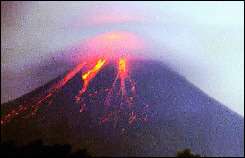Volcanic eruptions found to poke holes in ozone layer

Volcanic eruptions destroy ozone and create ‘mini-ozone holes’, according to two new studies by researchers at the Universities of Cambridge and Oxford.
The new research, spearheaded by Dr Genevieve Millard at the Department of Earth Sciences, University of Cambridge, discovered that volcanic gases released during eruptions accelerate reactions that lead to ozone destruction. The researchers found that even relatively small volcanic eruptions can destroy ozone and create localised ‘holes’ in the stratosphere.
Previously, scientists had concentrated on the climatic effects of the tiny particles of volcanic sulphate created from the sulphur dioxide gas emitted during an eruption. For the first time, analysing data from a 2000 eruption of the Hekla volcano, Iceland, the researchers discovered that volcanic gases may also lead to the formation of ice and nitric acid particles. This is a critical finding as these particles ‘switch on’ volcanic chorine gases, accelerating reactions that lead to ozone destruction.
Dr Millard said: 'We have shown for the first time that volcanic eruptions which penetrate the stratosphere can lead to the formation of the type of clouds that promote reactions with volcanic chlorine gases - gases that destroy stratospheric ozone and lead to the formation of "mini-ozone holes".
The ozone losses due to the small eruption at Hekla lasted for about two weeks, and eventually returned to normal levels. This is the first time that people have observed the complete removal of local ozone following a volcanic eruption.
'Now we want to find out what might happen to the ozone layer after a much larger eruption', said Dr David Pyle, University of Oxford, project coordinator, 'for example is there significant loss of ozone, and increased ultra-violet radiation, at low latitudes following large explosive eruptions? We want to understand this, so that we can have a better picture both of what might have happened in the past, and of what may happen in the future.'
Citation: Millard G. A., T. A. Mather, D. M. Pyle, W. I. Rose, B. Thornton (2006), Halogen emissions from a small volcanic eruption: Modeling the peak concentrations, dispersion, and volcanically induced ozone loss in the stratosphere, Geophys. Res. Lett., 33, L19815, doi:10.1029/2006GL026959.
Source: University of Oxford





















